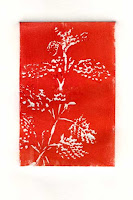Printmaking 12: Water-based oils
Winsor & Newton are my new heroes: water-based oil colours actually work for traditional intaglio printing.
As my poor colleagues in the printroom are well aware, oil-based inks and I don't mix well. It's not only that I hate getting my hands dirty (and I truly do hate it), but hands inky with oily colour makes the job of printing nearly impossible. Finger marks on the paper before printing is A Bad Thing. So I am delighted with the results of my water-based oil experiments.

The two images above are from the same linocut plate, both printed using the water-based oils. At left, the ink has been rubbed into the engraved area of the plate in the intaglio manner, with most ink wiped off the surface. The result is an inked embossing of the engraved area. The plate on the right has had the water-based oil ink rolled onto the surface but not into the grooves, resulting in a more traditional block-printing style. In either case, the use of the water-based oils is very successful. The colour is vibrant. The texture is slightly runnier than the traditional printer's inks and dries slightly more quickly, but this is manageable. And it cleans up with water! Magic.
But a linocut, with its large, broad-stroke printing area doesn't constitute a proper test. To ascertain if the ink was completely successful, it would also have to work on the thin lines of an etched copper plate, like the one used for the print below (a reworking of the image used in the life energy series). Again, the ink was beautifully successful. After working the ink into the plate with a dolly (a piece of coarse muslin called scrim wrapped tightly around itself like a little doll)
.

Winsor & Newton, I cannot tell you how pleased I am at these results. One of the best parts of printmaking is the elegant line of the plate after running it through the press. I think of it as the "bookplate effect". But the inconvenience and irritation of the oily inks always put me off it, or at the very least left me only doing blind embossings, i.e., pressing the plate without ink. I was thinking that only screenprinting would truly be available to me, but the world is now my lobster. Or it will be when I get my own press. Expensive? Yes, but I'm worth it.
